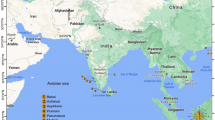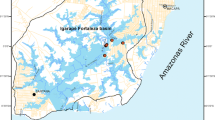Abstract
Ecological studies of host–parasite interactions in the tropics are generally restricted to descriptive taxonomic aspects. The present study had as its objective identification of the metazoan ectoparasites of piranhas Pygocentrus nattereri, Serrasalmus spilopleura and S. marginatus in lentic and lotic environments in the Pantanal region, Brazil. We collected the samples in the Miranda River basin and in three ponds. We caught fishes using hook and line. We found that branchiuran crustaceans infested about 30% of the piranhas. We found four branchiuran species: Dolops carvalhoi, Argulus elongatus, Argulus aff. juparanaensis and Dipterolpetis hirundo, which represent new findings in host–parasite relationships in the Neotropics. When comparing lotic and lentic environments, we observed higher infestation rates in rivers than in ponds for all the hosts. P. nattereri had the highest prevalence and the intensity rates in both the environments. The body parts of hosts with the highest frequencies of parasitism were the ventral area in P. nattereri, the gullet area in S. spilopleura and ventral areas and external gills in S. marginatus. In relation to the prevalence of the parasites we observed significant differences between the hydrological seasons and the piranha species, nevertheless hosts were more parasitized in the dry season. The species with highest rates of infestation, P. nattereri and S. spilopleura, live in schools, which indicates that the high parasite load may be a direct consequence of the proximity between individuals. We believe that the higher rates of infestation in the dry season result from the increase in host density in drying ponds imitating the conditions found in fish farming. Seasonal changes in water level and temperature can also influence the rates of parasitism.
Similar content being viewed by others
References
Alcock, J. 1993. Animal Behavior: An Evolutionary Approach, Sinauer, Sunderland, Mass. 625 pp.
Arme, C. & R.W. Owen. 1967. Infections of the three-spined stickleback, Gasterosteous aculeatus L., with the plerocercoid larvae of Schistocephalus solidus (Muller, 1776), with special reference to pathological effects. Parasitology 57: 301–314.
Bortone, S.A., W.K. Bradley & J.L. Oglesby. 1978. The host-parasite relationship of two copepod species and two fish species. J. Fish Biol. 13: 337–350.
Britski, H.A., K.Z.S. Silimon & B.S. Lopes. 1999. Peixes do Pantanal: Manual de identificação. Brasília: Embrapa-SPI; Corumbá: Embrapa-CPAP. 184 pp.
Bush, A.O., K.D. Lafferty, J.M. Lotz & A.W. Shostak. 1997. Parasitology meets ecology on its own terms: Margolis et al. revisited. J. Parasitol. 83: 575–583.
Calheiros, D.F. & S.K. Hamilton. 1998. Limnological conditions associated with natural fish kills in the Pantanal Wetland of Brazil. Verh. Internat. Verein. Limnol. 26: 2189–2193.
Castro, A.L. 1985. Manual de identificação de invertebrados límnicos do Brasil: Branchiura. Brasília: CNPq, Coordenação editorial. 24 pp.
Cloutman, D.G. & D.A. Becker. 1977. Some ecological aspects of Ergasilus centrarchidarum Wright (Crustacea: Copepoda) on largemouth and spotted bass in Lake Fort Smith, Arkansas. J. Parasitol. 63: 372–376.
Crowden, A.E. & D.M. Broom. 1980. Effects of the eyefluke, Diplostomum spathaceum, on the behaviour of dace (Leuciscus leuciscus). Anim. Behav. 28: 287–294.
Eiras, J.C. 1994. Elementos de Ictioparasitologia. Fundação Eng. António de Almeida. 339 pp.
Goulding, M. 1980. The fishes and the forest: Explorations in Amazonian Natural History, University of California Press, Berkeley, 280 pp.
Hamann, M.I. 1995/1996. Fauna parasitaria de Serrasalmus spilopleura Kner, 1860 en ambientes leníticos de la província de Corrientes, Argentina. Rev. Ictiol. 4: 11–17.
Hamann, M.I. 1997/1998. Aspectos ecológicos de la relácion parasitaria entre juveniles de Braga fluviatilis Richardson, 1911 (Crustacea, Cymothoidae) y Serrasalmus spilopleura Kner, 1860 (Pisces, Characidae) en poblaciones naturales del Nordeste Argentino. Physis 55: 15–22.
Hamilton, S.K., S.J. Sippel, D.F. Calheiros & J.M. Melack. 1997. An anoxic event and other biogeochemical effects of the Pantanal wetland on the Paraguay River. Limnol. Oceanogr. 42: 257–272.
Hanek, G. & C.H. Fernando. 1978. The role of season, habitat, host age, and sex on gill parasites of Lepomis gibbosus (L.). Can. J. Zool. 56: 1247–1250.
Kabata, Z. 1981. Copepoda (Crustacea) parasitic on fishes: Problems and perspectives. Adv. Parasitol. 19: 1–71.
Lester, R.J.G. 1971. The influence of Schistocephalus plerocercoids on the respiration of Gasterosteus and a possible resulting effect on the behavior of the fish. Can. J. Zool. 49: 361–366.
Lewis, R.M. & W.F. Hettler. 1968. Effects of temperature and salinity on the survival of young Atlantic menhaden, Brevoortia tyrannus. Trans. Am. Fish. Soc. 97: 344–349.
Lowe-McConnell, R.H. 1987. Ecological Studies in Tropical Fish Communities, Cambridge University Press, Cambridge. 382 pp.
Mago-Leccia, F. 1970. Estudios preliminares sobre la ecología de los peces de los llanos. Acta Biol. Venez. 7: 71–102.
Malta, J.C.O. 1982a. Os argulídeos (Crustacea: Branchiura) da Amazônia Brasileira. Aspectos da ecologia de Dolops discoidalis Bouvier, 1899 e Dolops bidentata Bouvier, 1899. Acta Amazon. 12: 521–528.
Malta, J.C.O. 1982b. Os argulídeos (Crustacea: Branchiura) da Amazônia Brasileira, 2. Aspectos da ecologia de Dolops geagy Bouvier, 1897 e Argulus juparanaensis Castro, 1950. Acta Amazon. 12: 701–705.
Malta, J.C.O. 1984. Os peixes de um lago de várzea da Amazônia Central (Lago Janauacá, Rio Solimões) e suas relações com os crustáceos ectoparasitas (Branchiura: Argulidae). Acta Amazon. 14: 355–372.
Malta, J.C.O. & A. Varella. 1983. Os argulídeos (Crustacea: Branchiura) da Amazônia Brasileira 3. Aspectos da ecologia de Dolops sriata Bouvier, 1899 e Dolops carvalhoi Castro, 1949. Acta Amazon. 13: 299–306.
Milinski, M. 1984. Parasites determine a predator's optimal feeding strategy. Behav. Ecol. Sociobiol. 15: 35–37.
Ozer, A. & O. Erdem. 1999. The relationship between occurrence of ectoparasites, temperature and culture conditions: A comparison of farmed and wild common carp (Cyprinus carpio L., 1758) in the Sinop region of northern Turkey. J. Nat. Hist. 33: 483–491.
Pavanelli, G.C., J.C. Eiras & R.M. Takemoto. 1999. Doenças de peixes: profilaxia, diagnóstico e tratamento. Paraná: EDUEM, Nupélia, Maringá. 264 pp.
Pennycuick, L. 1971. Quantitative effects of three species of parasites on a population of three-spined sticklebacks, Gasterosteous aculeatus. J. Zool. 165: 143–162.
Poulin, R. 1991. Group-living and the richness of the parasite fauna in Canadian freswater fishes. Oecol. 86: 390–394.
Poulin, R., M.A. Curtis & M.E. Rau. 1991. Size, behaviour, and acquisition of ectoparasitic copepods by brook trout, Salvelinus fontinalis. Oikos 61: 169–174.
Rawson, M.W., Jr. 1977. Population biology of parasites of striped mullet, Mugil cephalus L. Crustacea. J. Fish Biol. 10: 441–451.
Sazima, I. & F.A. Machado. 1990. Underwater observations of piranhas in Western Brazil. Env. Biol. Fish. 28: 17–31.
Silva, J.S.V. & M.M. Abdon. 1998. Delimitação do Pantanal Brasileiro e suas sub-regiões. Pesq. Agropec. Bras. 33: 1703–1711.
Szalai, A.J. & T.A. Dick. 1991. Evaluation of gill nets, fyke nets, and mark-recapture methods to estimative the number of hirudinea and crustacea on fish. J. Parasitol. 77: 914–922.
Tanaka, L.K. 2000. Aspectos ecológicos dos parasitos de Serrasalmus marginatus Valenciennes, 1847 e Serrasalmus spilopleura Kner, 1860 (Characiformes, Serrasalmidae) do rio Baía, planície de inundação do alto rio Paraná, MS. M.Sc. Thesis, Universidade Estadual de Maringá, Maringá. 32 pp.
Thatcher, V.E. 1991. Amazon fish parasites. Amazoniana 11: 263–572.
Wilson, E.O. 2000. Sociobiology: The New Synthesis, Harvard University Press, Cambridge, Mass. 697 pp.
Author information
Authors and Affiliations
Rights and permissions
About this article
Cite this article
Nobre Carvalho, L., Del-Claro, K. & Takemoto, R.M. Host–parasite interaction between branchiurans (Crustacea: Argulidae) and piranhas (Osteichthyes: Serrasalminae) in the Pantanal wetland of Brazil. Environmental Biology of Fishes 67, 289–296 (2003). https://doi.org/10.1023/A:1025899925545
Issue Date:
DOI: https://doi.org/10.1023/A:1025899925545




